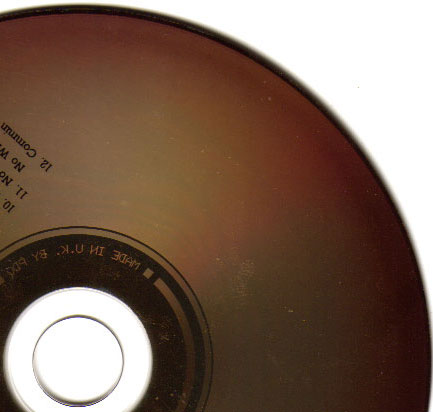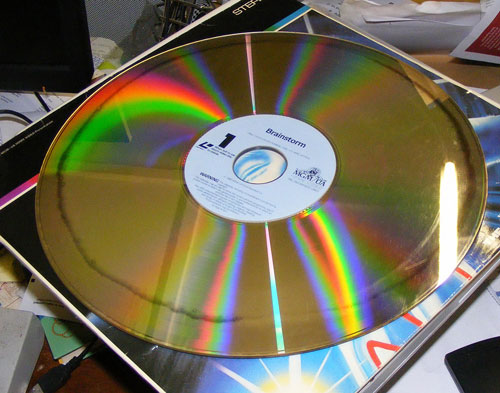How degraded optical discs
CDs were once advertised as unkillable “plates”, but the truth is still much more complicated.

Often it looks like a coffee stain - a noticeable discoloration from which it is impossible to get rid of. Sometimes it looks like pin shots on the surface. Sometimes the whole disc changes color. In any case, faced with the so-called. “Decay”, or the degradation of the discs, you lose an excellent album or an interesting film. This is a serious matter - whether you will be a digital archivist or just a person who wants to see a movie in a strange format like Laserdisc.
Probably, if you cut the disk with a knife, this will not do any good, and you can destroy it by putting out a cigar about it. But you can pour jam on it, and nothing will come of it.
- A representative from EMI commented on the stability study of a CD conducted by the Nimbus recording studio in 1988.
Nimbus, the first CD maker in Britain, said that according to the results of an internal study, most disks self-destruct after 8-10 years. The discoveries of the company went against the generally accepted theories of the time, according to which the CDs were indestructible; wrong paint was blamed for everything, which worsened the quality of the disks. At first, record companies were skeptical of this, but it turned out that Nimbus was worried.
In 2010, a blogger on the RF Generation gaming site, annoyed by several identical cases, when buying games it turned out that the discs had "rotted" before they came to him, wrote an open letter to the community of game collectors , urging them to pay attention to this the problem.
')
The blogger under the pseudonym slackur described a history that was heart-rending for any collector: after reading about the problem of disc degradation, he checked his collection, most of which was in excellent condition, and found white dots on a variety of discs - the main sign of “disc decay” or degradation of optical media.
And although this is just one small point, it is a fatal damage. The polishing process will not return lost data. The game is permanently damaged, and over the years, most likely, everything will only get worse.
Many online sources claim that this problem is limited in scope and concerns only discs produced by several manufacturers for several years (as well as CD-R), and that it is not widely distributed.
But after learning about it, I checked my several hundred discs, Sega CD, Turbo CD, Saturn and Dreamcast, and found dozens of discs with this problem. Several expensive games in my collection were in a state of new - but when I looked at the light, I found one or several small white dots indicating damage. Some of them, I tried to lose after a few years did not touch them, and found that they hang or refuse to start. I had a few games in the original packaging , opening which, I discovered the same problem.
It was an incredible nightmare for a collector like me.
Michelle Yukket, a media preservation specialist from the Library of Congress, often faces such incidents at work. She says that such silent destruction, which manifests itself in various forms - the “ bronzing ” of disks, small dots appearing on disks, or the degradation of edges, became a very serious problem for the national library when it began to compile music in CD format. The weaknesses of this format very quickly became apparent.

Michel Euket
It should be remembered that although optical discs look the same, they have small differences in production that can affect the final result. In the old disks could use not such chemicals as in the new, and with time the production technologies become more complex.
“Many of the reasons for the early failures of these discs would disappear as technology improves. But with the advent of more and more complex disk formats, new reasons for failure appear, ”explains Uket. By the way, she calls the terminology of "rotting discs" inaccurate, because disk failures happen due to the fact that the protective layer did not cope with its task.
Whether you are trying to protect the cultural heritage of your country or your own collection, you have to admit that the degradation of disks is a huge and painful problem.
The largest producer in Britain, the Philips CD and Dupont Optical (PDO), has been providing customer support for 15 years, created exclusively to replace customers’s “bronzed” discs. From 1988 to 1993, PDO released a variety of discs that used low-quality lacquer, unstable to sulfur. This became a problem, as traces of sulfur were found in the booklets and tabs of the discs — that is, what was supposed to protect the discs damaged them.

As a result, the aluminum layer was subjected to corrosion, which caused the disc to change color to bronze - and the quality of the audio recordings suffered. PDO maintained a hotline that allowed customers to replace damaged discs from 1991 to 2006.
Five facts from the Library of Congress about the degradation of the CD
1. Disks with significant damage can be partially read. “If there is an unrecoverable error on the disk, then depending on where it is located, quite a lot of data can still be recovered,” she explained in an interview. - Many discs with errors can be played, and depending on the content - audio, video, data - even an unrecoverable error may not be so serious.
2. A scratch on the top of a CD causes more problems than a scratch on the bottom. Why? Yuket says that the standards for optical formats include error correction schemes that can cope with scratches on the bottom surface of disks. “But, since the reflective layer is covered only with a thin acrylic layer with a label, scratches on the top surface can penetrate this layer and damage the reflective layer.”
3. In general, DVD has more reliability than CD, because the reflective layer of the disc is pressed inside polycarbonate discs. But these discs are more prone to breaks due to chemical reactions that occur between the layers and polycarbonate - as a result, the discs can split off over time. Dual-layer drives are even worse.
4. Recordable discs live less, in part because of the organic dye used to write bytes to discs. Yuket says that it is subject to degradation - especially for recordable DVDs, which have a higher light sensitivity level, as well as a higher probability of failure. In addition, according to her, the way a disc is recorded determines its lifetime - a poorly recorded disc will deteriorate faster.
5. Preserving discs helps proper storage and handling. According to Yuket, according to their internal tests (which determined the expected lifetime of the disks based on the error rate), the disks will live longer, for many decades, if they are properly handled and stored in the right conditions. Disks stored at elevated temperature and / or humidity will be stored less.

Laser disc degradation
Owners of laser discs can tell you about the horrors of laser rotting.
If the owners of CDs and DVDs want to know their future, they just need to ask the owners of laser discs, who are too familiar with the untimely death of their paid content in the 1980s. The latter just use the term "laser rot", emphasizing the fact that they were the first in the matter of optical discs.
In the case of laser discs, glitches appear when playing them. At first, it's just a little noise in the image. The discs themselves have a hazy appearance (as in the video above), and the results of degradation are quite disappointing, considering the platform’s reputation as a high-quality video and audio carrier.
In the community of laser discs, this problem is so widespread that there is a separate page on the Laserdisc Database (LDDB), where collectors gather, a page dedicated to the most popular films whose CDs suffer from such degradation - in fact, a warning that these Drives are not worth buying.
Just as the PDO factory supplied British users with discs that turned into bronze, factories in the United States were often accused of producing low-quality laser discs - especially the Sony DADC factory in Indiana.
If you dig, you can find a lot of conspiracy theories explaining why it was in this factory that particularly unreliable discs were made.
"Over time, most factories face the degradation of disks, but most of them were able to cope with this," wrote John Seiber , the guru of laser disks, on his website in 2005. - And DADC could not. "
The problem faced by laser discs is that people strive to preserve their possessions. Last year, the author of Engadget, Sean Cooper, described how he almost threw out the Dragon's Lair slot machine because he could not find a working copy of the original disc. This is natural, because they were made more than 30 years ago. As a result, Cooper had to replace the original disk with the Raspberry Pi. Not so authentic, but at least it works.
There is something to enjoy entertainment in the format in which they were conceived, but from the mainstream point of view, companies and most users are ready to switch to new technologies. And what about outdated things? Often companies do not pay enough attention to the formats that they once sold, after society loses interest in them.
Although Yuket believes that “ archival quality ” recordable discs are suitable for the best long-term data storage, his colleague Peter Alia, a digital data conversion specialist, believes that the switch to cloud computing has pushed the company away from long-term support for its data formats.
“At the client level, there is a rejection of physical carriers, so I think that most companies are not perplexed by this issue,” he explained to me in an interview. - Consumers are more interested in long-term access to personal data archived in a remote repository, and quick access to entertainment (music, video, games). It would be nice if the producers had priority in the long-term support of their products, but you should probably not expect this. ”
Things are aging, losing their gloss. In the era of clouds, consumers have come pretty close to making this issue a problem for someone else. But archivists cannot afford such luxury.
Source: https://habr.com/ru/post/401527/
All Articles